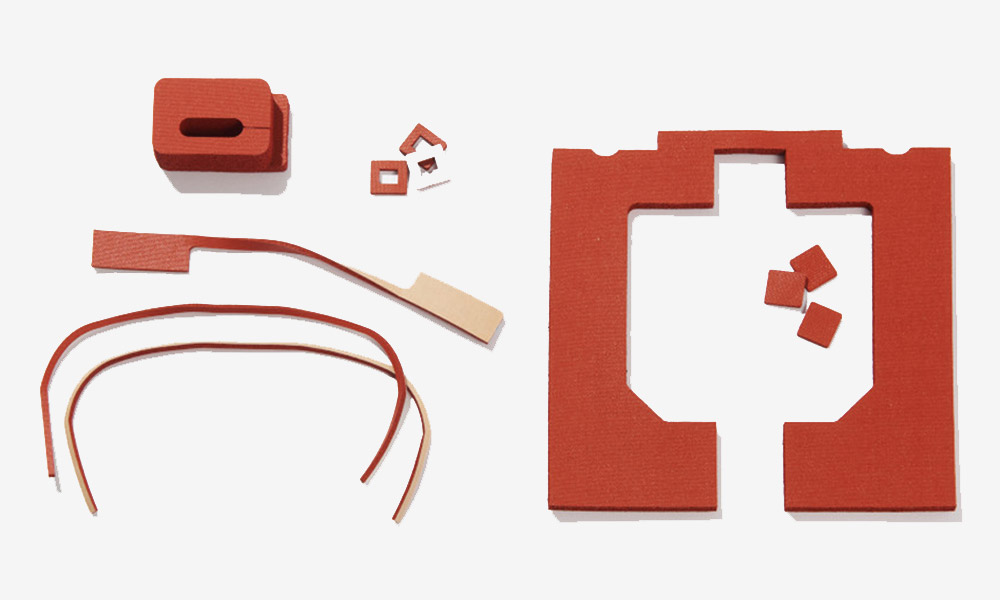Material
Silicone Sponge
Robust sealing and cushioning materials for the toughest of conditions
Robust sealing and cushioning materials for the toughest of conditions

Stockwell Elastomerics regularly applies 3M and Adchem pressure sensitive, acrylic and silicone adhesive backings to closed cell silicone sponge materials. More detailed technical information about applying acrylic adhesive, silicone adhesive and combination adhesive to silicone sponge is available. Adhesive backed gaskets and pads allow for faster assembly during final installation. In addition to furnishing parts with peel and stick backings, Stockwell Elastomerics offers conductive surface coatings for high temperature ESD grounding applications.
Silicone sponge and silicone rubber sheets are readily fabricated into silicone sponge gaskets and cushioning pads. Fabricating processes at Stockwell Elastomerics include: die cutting, water jet cutting, flash (high speed knife) cutting, adhesive lamination, strip slitting (silicone gasket tape) and custom assembly. Stockwell Elastomerics offers cut-to-size (waterjet) prototypes to help engineers and designers with “proof of concept”.
Kiss-cut silicone sponge gasketKiss-cut silicone spongeMost commercially available silicone sponge products are made from gum based polydimethylsiloxane (PMDS). The silicone elastomer is expanded at the time it is heat cured; the expansion process creates the closed cell sponge structure. The expanding process might be compared to adding yeast to bread to make it rise, creating compressible air pockets. Expanded closed cell silicone sponge materials offer many of performance benefits of solid silicone in a softer and more compliant form.
Visit the Silicone Sponge and Silicone Foam Sheet Material Data Sheets page for detailed technical information on these materials.
Stockwell Elastomerics offers the following expanded silicone sponge products in sheet/roll form, die cut or water jet cut parts. All products listed below are available with acrylic or silicone adhesive backing of choice. (View Stockwell Elastomerics’ adhesive options.)
Closed cell silicone sponges are available in tape rolls laminated with premium adhesive backing. Stockwell Elastomerics inventories many NORSEAL silicone sponge items in master rolls with adhesive backings, then slits and cuts custom and standard gasket tapes for quick delivery. Silicone gasket tape is also called a strip gasket or Strip-N-Stick®. Silicone adhesive backing is also available for extreme temperature and low surface energy applications. Silicone gasket tapes are most commonly used for enclosure gaskets, rack gaskets or other large gasket applications – dovetail joints are also available for faster assembly and more effective sealing. View more information on silicone sponge gasket tapes offered by Stockwell Elastomerics.
UL 94V-0 rated silicone sponge being exposed to a flame from a torch Silicone sponge is used for enclosure gaskets, cushioning pads. Silicone foam and silicone sponge have a wide temperature range but without special chemistry they will not pass the vertical burn test. R10400 silicone sponge and the HT-800 silicone foam family are formulated to meet the stringent UL 94V-0 flame test.
Silicone sponge, also called closed cell silicone sponge or expanded silicone, is derived from a thin sheet of uncured silicone gum that expands to a controlled thickness while curing in a high temperature press or rotocure operation. Closed cell means that the cells are non-interconnecting, therefore they do not allow water to wick through the sponge. Generally, silicone sponges have superior mechanical properties and are considered to have a complete closed cell structure. Silicone sponge often provides better water sealing in wash-down applications as compared to silicone foam.
Silicone foam is normally considered to be an open cell, lightweight product that is derived from liquid silicone ingredients that are cast onto a liner and cured in an oven. Higher density silicone foams have been developed, in recent years, that are suitable for water sealing. Low density open cell silicone foams may allow moisture to pass through the cell structure unless the design allows for extensive deflection of the gasket. In contrast, higher density silicone foam products will have a higher proportion of closed cells compared with medium or low density grades. With the proper amount of deflection, it is possible to achieve a good long term weather seal and rain seal with silicone foam.
Many silicone sponge materials meet AMS3195, AMS3196, MIL-R-46089, MIL-R-6130 Type II and ASTM D6576 specifications. UL 94V-0 flame rated silicone sponge is available. Also see Silicone Foam materials for other UL 94, UL 50, UL 50E, UL 508 (UL 60947), UL 1570, UL 1571, UL 1572, UL 157 requirements.
Although silicon sponge or silicon is called out frequently called out on drawings, silicone sponge is the widely accepted terminology used in the rubber industry. Expanded silicone is also used.
Contact Us for further assistance with custom fabricated silicone sponge gaskets, expanded silicone, closed cell silicone sponge and sheet silicone sponge gaskets and pads.